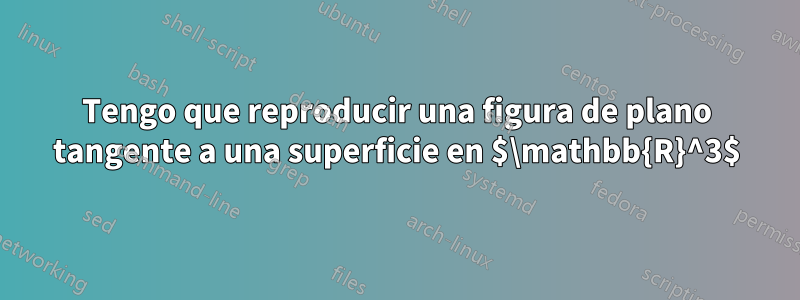
Tengo que reproducir la siguiente figura.
Editar:El siguiente código está bien. Sólo tengo que ajustar el plano tangente, gard F.
\documentclass[tikz,border=2mm]{standalone}
\usepackage{amsmath} % \boldsymbol
\usetikzlibrary{calc,decorations.pathreplacing} % decorations is for the 'underbrace'
\tikzset
{
surface/.style={black,shading=ball,fill opacity=0.2},
plane/.style={black!40!black,fill=black!90!black,fill opacity=0.1},
curve/.style={black,thick},
underbrace/.style={decorate,decoration={brace,raise=1mm,amplitude=1mm,mirror}},
}
\begin{document}
\begin{tikzpicture}[line cap=round,line join=round,scale=2]
% coordinates
\coordinate (O) at (0,0);
\coordinate (X) at (234:2.5);
\coordinate (Y) at (353:4.5);
\coordinate (Z) at (0,3.2);
\coordinate (A) at ($(O)!0.06!(Y)$);
\coordinate (B) at ($(A)+(0,2.8)$);
\coordinate (C) at ($(B)+(322:2.8)$);
\coordinate (D) at ($(C)+(A)-(B)$);
\coordinate (E) at ($(A)!0.75!(B)$);
\coordinate (P') at ($(A)!0.27!(D)$);
\coordinate (Q') at ($(A)!0.64!(D)$);
\coordinate (P) at ($(P')+(0,2.4)$);
\coordinate (Q) at ($(Q')+(0,2.15)$);
\coordinate (Sx) at ($(O)!0.72!(X)$);
\coordinate (Sy) at ($(O)!0.9!(Y)$);
\coordinate (Sz) at ($(O)!0.62!(Z)$);
\coordinate (T1) at ($(P)-(322:1)$);
\coordinate (T2) at ($(P)+(322:1.3)$);
\coordinate (R1) at ($(P')-(X)$);
\coordinate (R2) at ($(Q')-(Y)$);
\coordinate (R3) at (intersection of P'--R1 and Q'--R2);
% axes
\draw[-latex] (O) -- (X) node (X) [left] {$x$};
\draw[-latex] (O) -- (Y) node (Y) [right] {$y$};
\draw[-latex] (O) -- (Z) node (Z) [above] {$z$};
% plane, back
\draw[surface] (Sx) to[out=-25,in=200,looseness=0.7] (D) to[out=20,in=240,looseness=0.7] (Sy) to[out=100,in=10] (E) to[out=190,in=20] (Sz) to[out=220,in=100] cycle;
% plane, front
\draw[latex-,shorten <=2mm,shorten >=4mm] (P) -- (1.8, 2.3) node {$P(x_0,y_0,z_0)$};
% curve C
\draw[curve] (D) to[out=90,in=305] (Q) to [out=125,in=322] (P) to[out=142,in=10] (E);
% tangent
\draw[thick,red] (T1) -- (T2);
% points
\foreach\i in{P}
\fill (\i) circle [radius=.25mm];
\node at (-1.1,0.7) [blue] {$S$};
\node at (2.1,0.7) [curve] {$C$};
\end{tikzpicture}
\end{document}
Respuesta1
En este caso optaría por un dibujo 3D completo, ya que de esta manera es más fácil dibujar las perpendiculares. En 'tu' código no había perpendiculares, solo líneas horizontales y verticales, así que utilicé un enfoque 2d (¿Cómo dibujar las derivadas direccionales en TiKz?). Para este estoy representando la superficie como parte de una esfera. ver las líneas auxiliares comentadas.
Como esto:
\documentclass[tikz,border=2mm]{standalone}
\usepackage{amsmath} % \boldsymbol
\usetikzlibrary{3d,calc,perspective}
\tikzset
{
surface/.style={draw=blue,shading=ball,ball color=cyan!60!blue,fill opacity=0.8},
plane/.style={draw=orange,fill=orange,fill opacity=0.6},
vector/.style={draw=magenta,thick,-latex}
}
\begin{document}
\begin{tikzpicture}[line cap=round,line join=round,3d view={110}{20},scale=1.5]
% dimensions
\def\r{2} % sphere radius
\def\c{0.5} % center C position
\def\cx{0.5} % curve x position
\pgfmathsetmacro\ra{sqrt(\r*\r-\c*\c)} % radius, arcs in the sphere
\pgfmathsetmacro\rc{sqrt(\r*\r-(\c+\cx)*(\c+\cx))} % radius, curve
\pgfmathsetmacro\axy{asin(\c/\r)} % angles in xy plane
\pgfmathsetmacro\ayz{asin(\c/\ra)} % angles in yz plane
\pgfmathsetmacro\ar{asin((\c+\cx)/\r} % rotation angle for plane and vectors
% coordinates
\coordinate (C) at (-\c,\c,0); % sphere center
\coordinate (O) at (0,0,0);
\coordinate (P) at (\cx,\c,{sqrt(\r*\r-(\c+\cx)*(\c+\cx))});
\coordinate (G) at ($(C)!1.7!(P)$); % gradient
% some auxiliary lines
%\begin{scope}[gray,very thin]
% \draw (C) circle (\r cm);
% \draw (C) --++ (\r,0,0);
% \draw[canvas is xy plane at z=0] (C) circle (\r);
% \draw[canvas is xz plane at y=0] (-\c,0) circle (\ra);
% \draw[canvas is yz plane at x=0] (\c,0) circle (\ra);
% \draw[canvas is yz plane at x=\cx] (\c,0) circle (\rc);
%\end{scope}
% axes
\draw[-latex] (O) -- (\r+1,0,0) node[left] {$x$};
\draw[-latex] (O) -- (0,\r+1,0) node[right] {$y$};
\draw[-latex] (O) -- (0,0,\r+1) node[above] {$z$};
% surface
\draw[surface] (C) ++ (-\axy:\r) arc (-\axy:90-\axy:\r)
{[canvas is yz plane at x=0] arc (0:90+\ayz:\ra)}
{[canvas is xz plane at y=0] arc (90-\ayz:0:\ra)};
% curve
\draw[canvas is yz plane at x=\cx,yellow] (\c+\rc,0) arc (0:{90+asin(\c/\rc)}:\rc);
% plane
\draw[plane,shift={(P)},rotate around y=\ar,canvas is xy plane at z=0] (-1,-1.5) -|++ (2,3) -| cycle;
% Point P
\fill (P) circle (0.4mm) node[below] {$P$};
% vectors
\begin{scope}[shift={(P)},rotate around y=270+\ar,canvas is xy plane at z=0]
\draw[vector] (0.04,0) -- (G) node[above right,black] {$\nabla F(x_0,y_0,z_0)$};
\draw[vector] (0,0.04) --++ (0,0.8,0) node[right,black] {$\boldsymbol{\mathrm{r}}'(t)$};
\draw[magenta] (0,0.2) -| (0.2,0) ;
\end{scope}
\end{tikzpicture}
\end{document}





